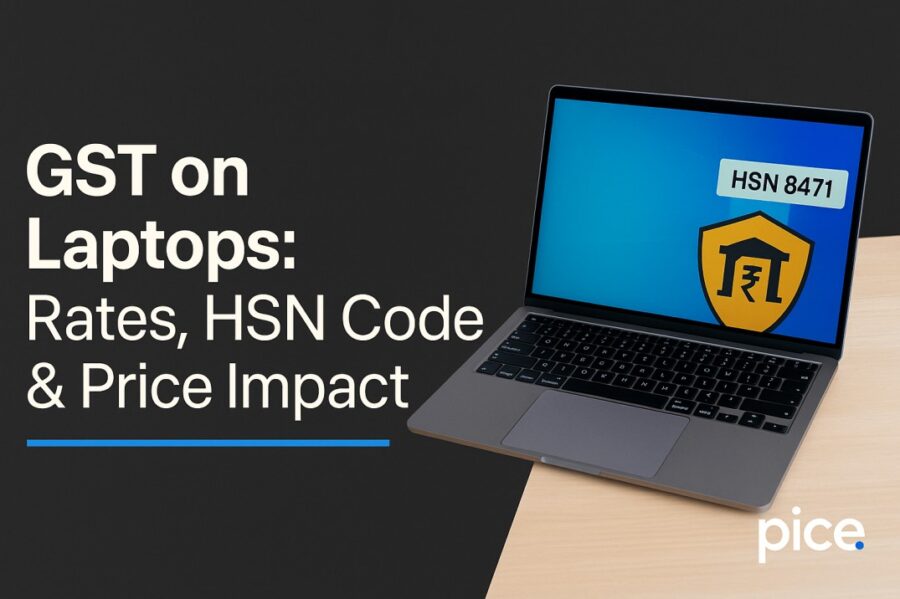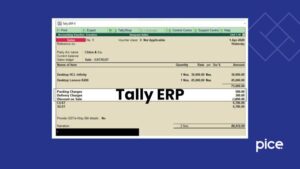GST on Laptops: Rates, HSN Code & Price Impact
- 13 Nov 25
- 9 mins

GST on Laptops: Rates, HSN Code & Price Impact
Key Takeaways
- GST on laptops, computers, and accessories is uniformly charged at 18% across India.
- HSN Code 8471 governs laptops, desktops, storage units, and most computer peripherals for GST classification.
- Under GST, ITC can be claimed on laptops used for business purposes, reducing overall tax liability.
- Pre-GST laptop taxation varied by state, but GST introduced uniformity, clarity, and smoother interstate pricing.
- Knowing GST rates and HSN codes helps buyers estimate final costs and ensures accurate tax compliance.
Did you know that the Goods and Services Tax or GST on laptops can highly impact the final price you are required to pay for your device? With the Indian laptop market projected to reach over Rs. 5 crore by 2025, a thorough understanding of the applicable GST rates for laptops and computers is crucial.
We will break down the GST rates which apply and the corresponding HSN codes for laptops, desktops, and other devices. This shall assist you in making informed decisions as you proceed with your purchase, whether as a business owner or as an individual buyer interested in tax filing accuracy and compliance.
About GST on Laptops
Let us get to the numbers so you can have more clarity on the topic! The GST rate which applies to laptops in India is 18% of the Maximum Retail Price or MRP. This is a uniform rate which fetches consistency to laptop pricing country-wide.
This, in turn, makes tax compliance much simpler for buyers as well as sellers under the framework of Integrated Goods and Services Tax (IGST) for inter-state transactions.
But here's the catch: the GST Council has the power to tweak this rate from time to time based on tax slabs or economic shifts. So, one has to stay in the loop to keep up with the necessary updates which might affect their future laptop/computer purchase experience.
Desktop Computers GST Rates
Headed to the shop for computers soon? Here's what to expect in terms of the associated GST rates! The GST rate which applies to the purchase of computers (desktops and laptops), is 18%. That's not all - most of the desktop computer accessories also come under the same 18% GST umbrella.
This allows for more consistency as well as clarity on the tax structure for tech products within the country, including software products and input devices like web browsers that enhance digital usage.
Taxes on Laptops in the Pre-GST Era
Prior to the GST system being introduced in India, laptops were taxed under 'Value Added Tax or VAT'. This rate varied from state to state, usually ranging between 14% - 15%. Central Sales Tax (CST) was an additional levy upon interstate purchases.
This led to different pricing of the products across regions in India. The situation caused much confusion, pushing people to hunt in hopes of finding better deals elsewhere, especially in high-value components like Central Processing Units or mainframe computers.
Computer Devices, GST Rates & HSN Codes
Refer to the table below for the GST rates and HSN codes against certain computer devices:
| Products | HSN Code | GST Rate |
| GST on Laptops & desktop computers | 8471 | 18% |
| GST on PCs (Personal computers) | 8471 30 10 | 18% |
| GST on Other digital automatic data processing machines which are portable | 8471 30 90 | 18% |
| GST on Microcomputers | 8471 41 10 | 18% |
| GST on mainframe/large computers | 8471 41 20 | 18% |
| GST on Other automatic data processing machines | 8471 41 90 | 18% |
| GST on Presented in the form of systems | 8471 49 00 | 18% |
| GST on Processing units (Does not include those under subheadings 8471 41, 8471 49) | 8471 50 00 | 18% |
| GST on Combined input/output units | 8471 60 10 | 18% |
| GST on Printers (specifically graphic printers) | 8471 60 24 | 18% |
| GST on Plotters | 8471 60 25 | 18% |
| GST on Other printers | 8471 60 29 | 18% |
| GST on Keyboards | 8471 60 40 | 18% |
| GST on Scanners | 8471 60 50 | 18% |
| GST on Mouse | 8471 60 60 | 18% |
| GST on Other input/output devices | 8471 60 90 | 18% |
| GST on Storage units | 8471 70 | 18% |
| GST on Floppy disk drives | 8471 70 10 | 18% |
| GST on Hard disk drives | 8471 70 20 | 18% |
| GST on Removable or exchangeable disc drives | 8471 70 30 | 18% |
| GST on Magnetic tape drives | 8471 70 40 | 18% |
| GST on Cartridge tape drives | 8471 70 50 | 18% |
| GST on CD-ROM drives | 8471 70 60 | 18% |
| GST on Digital video disc drives | 8471 70 70 | 18% |
| GST on Other storage devices | 8471 70 90 | 18% |
| GST on units of other automatic data processing machines | 8471 80 00 | 18% |
| GST on other data processing machines which are not included under other subheadings | 8471 90 00 | 18% |
Calculation of GST on Laptops & Computers
When one is purchasing a laptop or a computer, the GST is calculated as a percentage of the MRP. This value is 18% of the price tag. Refer to the example provided in the next section to understand the context better.
This is particularly useful for businesses managing inter-state transactions, and ensures they comply with the proper customs duty procedures in case of imports.
Example of Calculation of GST on Laptops & Computers
Suppose an individual buys a laptop which is priced at ₹50,000. The applicable GST in this case would amount to:
● (Price of Laptop x GST Rate) / 100 = GST
● So, (₹60,000 * 18) / 100 = ₹10,800 (GST)
Thus, the total price of the laptop will be ₹60,000 + ₹10,800 = ₹70,800. This is the amount payable by the individual.
Note that the actual GST calculation shall vary from the case study provided, depending on certain factors like applicable discounts, extra charges, system failure, or delivery issues. Make sure to consult a tax professional or check out the official government guidelines for accuracy with GST calculation settlements.
Having an understanding of the Input Tax Credits (ITC) and exemptions on computers and laptops shall allow businesses to offset GST liabilities while optimising their tax strategy.
Input Tax Credit (ITC)
One can claim ITC or Input Tax Credits on laptops or computers, given that the assets are being used for purposes of business. This entails that the GST one has paid upon purchasing said devices can be deducted from the GST value they collect on sales.
In order to claim ITC, be sure to have valid tax invoices handy, from the supplier. Also, make sure that the laptops and computers are used for business activities which are taxable under the processing programmes.
Make the effort to keep clear and precise records in order to elicit a smooth ITC claim process when reporting your GST returns. Always safeguard personal information transmitted in claims and ensure your internal procedures comply with your company's privacy policy and legal disclaimers.
Exemptions on GST
Most of the accessories/parts of laptops and computers are subject to the same 18% GST rate. No particular exemptions apply to such items.
However, there may be exceptions under broader categories. For example, exceptions shall be the purchases made for educational institutions/ government-related purposes. In certain special situations, software items imported with hardware may attract extra customs duty.
Ensure you are aware of the latest GST guidelines so that you can stay updated. You could also consult a tax expert and find out whether there are some exemptions available to your situation, especially if you have third-party transactions involved.
Conclusion
Overall, the focus is usually on the significance of knowing the applicability of GST on laptops and computers. This information is not only crucial for entrepreneurs but also for common buyers in the nation. The fixed 18% GST rate enables buyers to determine the overall price of the devices without hassles.
Stay informed about GST rates, Input Tax Credits, exemptions and beyond as individuals or as business runners. Navigate the tax landscape with more confidence and arrive at smarter purchasing decisions.
Don’t forget to regularly review your Privacy Policy, Legal Disclaimers, and software usage agreements, especially when purchasing devices intended to process sensitive Personal Information or for usage via web browsers connected to third-party tools.
💡If you want to streamline your payment and make GST payments via credit, debit card or UPI, consider using the PICE App. Explore the PICE App today and take your business to new heights.
 By
By 

















